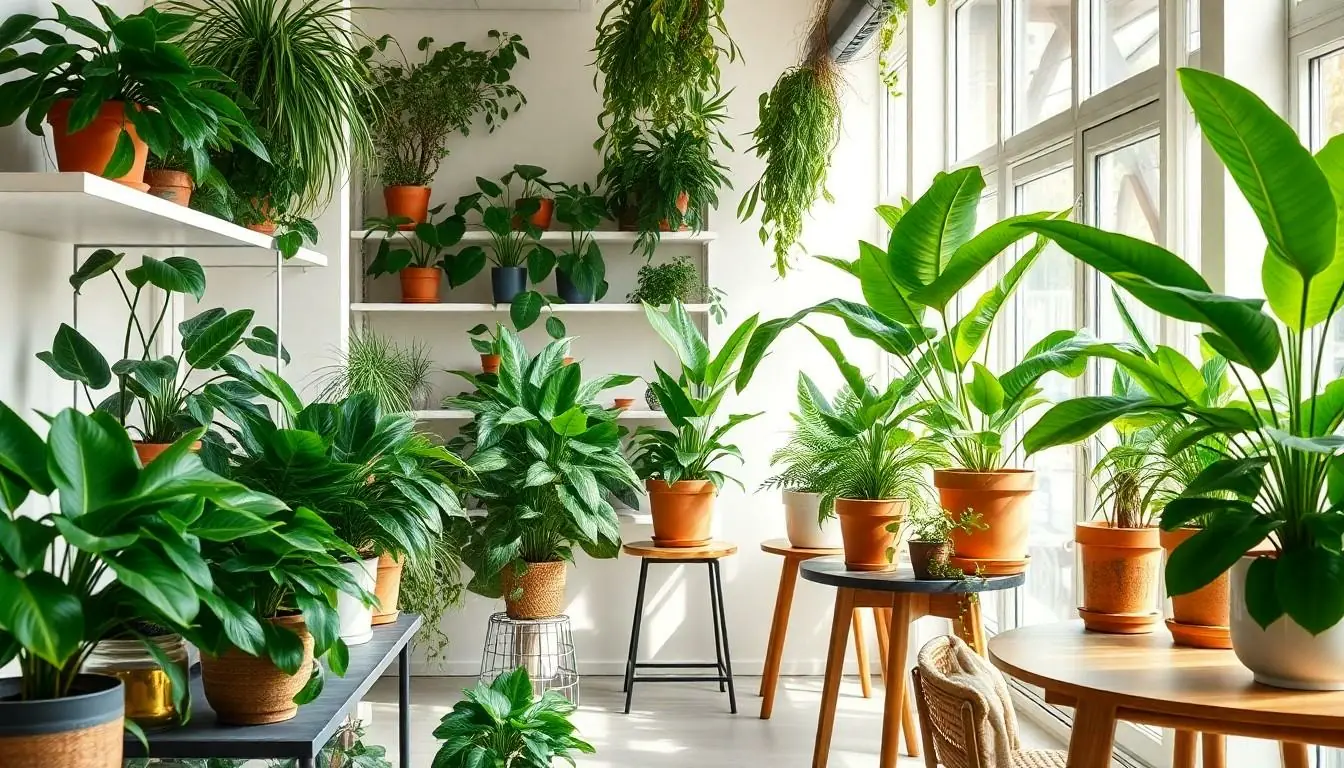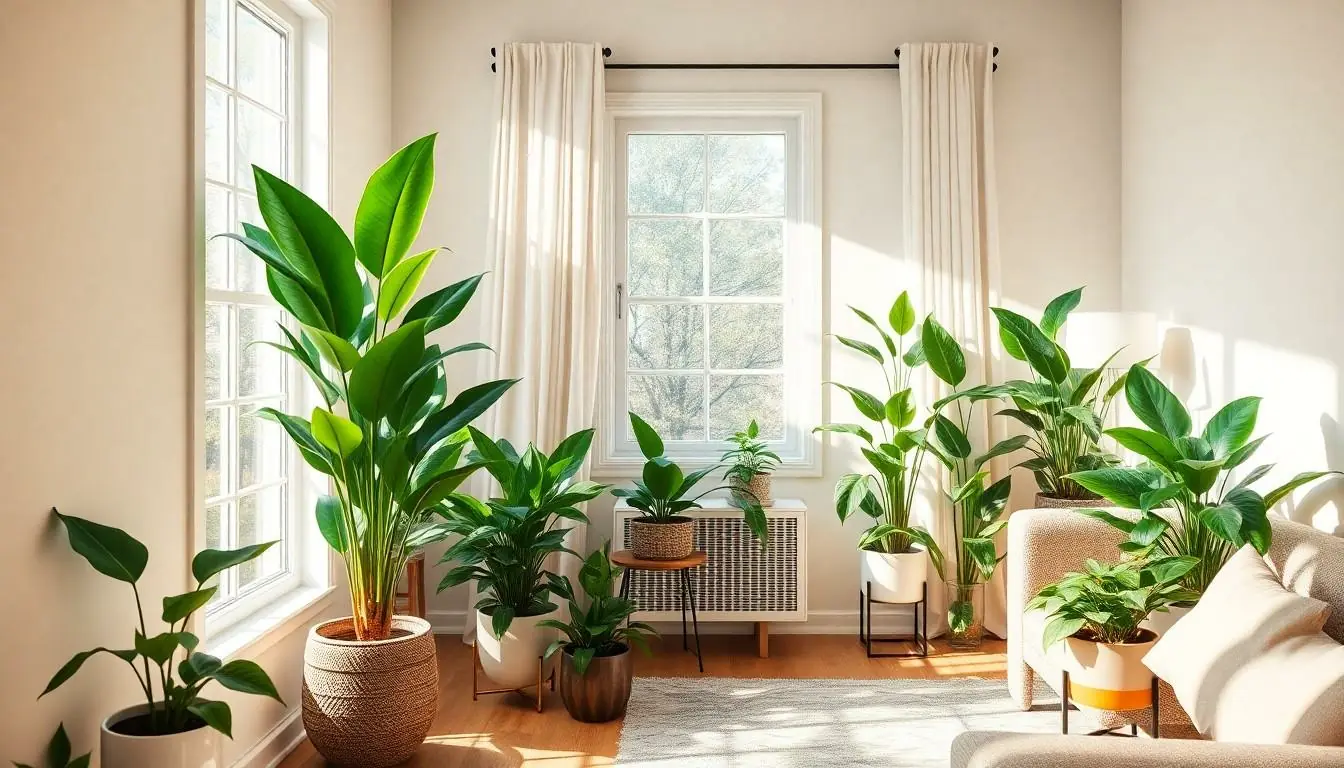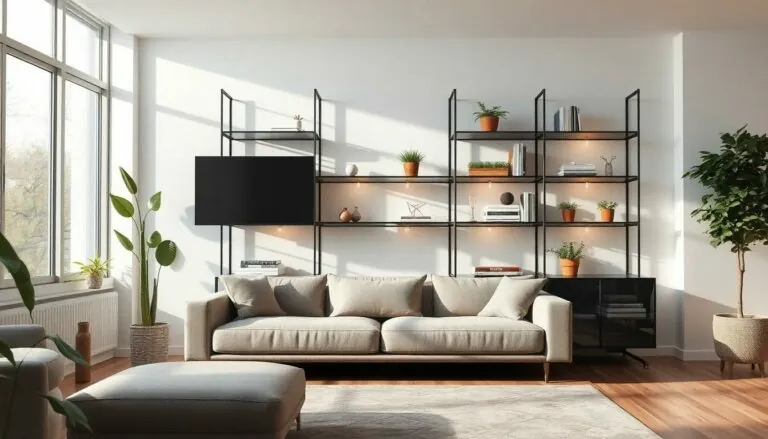Bringing a bit of greenery into the home isn’t just trendy; it’s practically a rite of passage for anyone looking to elevate their living space. From the resilient snake plant to the charming pothos, houseplants can transform any dull corner into a vibrant oasis. Plus, they’re known to improve air quality and boost mood—who wouldn’t want a leafy friend that makes them feel good?
But let’s be real: navigating the world of houseplants can feel like a jungle of confusion. With countless options out there, how’s one supposed to choose? Fear not! This guide highlights the 50 most common houseplants, complete with pictures to help you identify your future green companions. Get ready to meet your match and discover which plants will thrive in your home, all while adding a touch of personality to your space.
Table of Contents
ToggleOverview of House Plants
House plants serve multiple purposes beyond decoration. They improve indoor air quality by filtering pollutants and releasing oxygen. Various species thrive in different environments, making it possible for anyone to find a suitable plant. Some plants require minimal care, while others demand more attention, catering to different lifestyles.
Many popular house plants possess unique characteristics. For example, snake plants excel in low-light conditions, making them ideal for darker corners. Meanwhile, peace lilies bring elegance with their beautiful flowers and enhance humid environments. Certain varieties, like succulents, thrive in bright light and require infrequent watering.
Individuals often choose house plants based on aesthetic appeal. Foliage color, leaf shape, and plant size play significant roles in enhancing interiors. Additionally, people appreciate plants for their ability to create a sense of calm and tranquility within their spaces.
The maintenance of house plants varies widely. Some plants need weekly watering, while others can go weeks without moisture. Understanding specific needs ensures that home gardeners maintain healthy plants.
A diverse range of house plants exists, providing options that suit different tastes and preferences. From trendy fiddle leaf figs to timeless pothos, the choices are abundant. Engaging with the variety of plants can enhance both indoor environments and personal well-being.
Benefits of Indoor Plants

Indoor plants offer numerous benefits, from improving health to enhancing home aesthetics. These green companions play a significant role in creating a more inviting and wholesome living environment.
Health Benefits
Plants contribute actively to air quality by filtering pollutants and toxins. They generate oxygen, promoting a healthier atmosphere. Studies indicate that certain species, like spider plants and peace lilies, can reduce indoor air pollutants such as formaldehyde and benzene. Furthermore, the presence of plants can lower stress levels and improve overall well-being. Research shows that interacting with plants boosts mood and decreases feelings of anxiety. Regular exposure to indoor greenery also leads to increased focus and productivity, making them ideal additions to workspaces.
Aesthetic Appeal
Houseplants add vibrant color and unique texture to interiors. They create focal points in any room, enhancing visual interest. With various sizes and shapes available, plants like fiddle leaf figs and pothos suit diverse decor styles. Stylish pots further complement the plants and enhance their appeal. Using plants can bridge the gap between nature and indoor spaces, providing a sense of tranquility. Selecting the right plants helps achieve personal style while promoting a cozy atmosphere. The combination of foliage and creative placements transforms bland spaces into stunning examples of natural beauty.
50 Most Common House Plants with Pictures
Houseplants enhance homes by improving air quality and mood. Here’s a look at 50 popular houseplants, including vital characteristics and images for easy identification.
Plant 1: Snake Plant
Snake plants thrive in low light and require minimal water. Their long, upright leaves come in various shades of green, making them visually appealing. Many people choose snake plants for their ability to filter toxins like formaldehyde from the air.
Plant 2: Pothos
Pothos plants adapt easily to different environments. Vining stems with heart-shaped leaves often feature variegated patterns of yellow or white. This plant is famous for its air-purifying qualities and versatility in decoration.
Plant 3: Peace Lily
Peace lilies flourish in moderate to low light conditions. They produce elegant white flowers, adding touch to interiors. The plant is noted for reducing indoor pollutants and thrives in humidity.
Plant 4: Spider Plant
Spider plants are known for their arching green leaves and baby plantlets. They require bright, indirect sunlight and benefit from regular watering. Effective at filtering pollutants such as carbon monoxide, spider plants are family favorites.
Plant 5: ZZ Plant
ZZ plants tolerate neglect, making them perfect for busy individuals. Glossy green leaves grow from thick stems, adding a modern aesthetic. Hardy and drought-resistant, they thrive in low-light spaces.
Plant 6: Fiddle Leaf Fig
Fiddle leaf figs feature large, violin-shaped leaves that create a dramatic statement. They prefer bright, indirect light and need consistent moisture in the soil. Many decorators use them as focal points in home design.
Plant 7: Rubber Plant
Rubber plants exhibit deep green, shiny leaves that can reach impressive heights. This plant prefers bright light and moderate watering. Known for its air-purifying properties, it’s popular among plant enthusiasts.
Plant 8: Boston Fern
Boston ferns enjoy high humidity and indirect light. Their lush, feathery fronds bring vibrancy to any space. Regular misting and watering keep this plant healthy, making it ideal for bathrooms or kitchens.
Plant 9: Dracaena
Dracaena plants come in numerous varieties, each with distinct leaf patterns. They flourish in low light and require limited care. Many choose dracaena for its air-purifying abilities as well as its striking appearance.
Plant 10: Aloe Vera
Aloe vera is renowned for its medicinal properties and thick, fleshy leaves. This succulent thrives in bright, indirect sunlight and requires minimal water. Many people keep aloe for its soothing gel, useful for skin irritations.
Plant 11: Philodendron
Philodendrons are versatile and easy to care for. Their heart-shaped leaves grow rapidly, making them an attractive choice. These plants tolerate various light conditions but prefer indirect sunlight.
Plant 12: Jade Plant
Jade plants are popular succulents with fleshy leaves and thick stems. They thrive with minimal water, requiring bright light to flourish. Often viewed as symbols of good luck, they make ideal gifts and home additions.
Plant 13: Chinese Evergreen
Chinese evergreens thrive in various lighting conditions. Their mottled leaves offer unique patterns, enhancing decor. Not only are they low-maintenance, but they also filter toxins from the air.
Plant 14: Cast Iron Plant
Cast iron plants require little attention and adapt to almost any environment. Dark green leaves create a lush appearance in dim spaces. Their resilience makes them suitable for beginners.
Plant 15: Parlor Palm
Parlor palms grow slowly and can thrive in low light. Their feathery fronds add elegance to any room. This plant prefers moist soil but can tolerate occasional drying.
Plant 16: Elephant Ear Plant
Elephant ear plants boast large, dramatic leaves that can capture attention. This tropical plant flourishes in bright, indirect light and needs regular watering. Ideal for adding a bold statement to spaces.
Plant 17: Croton
Crotons are known for their colorful foliage, featuring vibrant shades of green, yellow, and red. Bright, indirect sunlight promotes their growth. These plants thrive in warm environments and require consistent moisture.
Plant 18: Bamboo Palm
Bamboo palms add a tropical touch with their slender, arching leaves. They thrive in part shade and require regular watering. Effective at purifying air, they suit homes and offices well.
Plant 19: Hoya
Hoyas are known for their waxy leaves and fragrant flowers. They require bright, indirect light and should dry out between waterings. Popular among collectors, hoyas can trail or be trained to climb.
Plant 20: Burro’s Tail
Burro’s tail is a succulent with trailing stems covered in plump leaves. This low-maintenance plant thrives in bright light and requires minimal watering. Many enjoy its unique appearance as a hanging plant.
Plant 21: Lipstick Plant
Lipstick plants produce unique, tubular flowers in vibrant hues. They prefer bright, indirect light and slightly moist conditions. The contrasting dark green leaves enhance the beauty of the flowers.
Plant 22: Swedish Ivy
Swedish ivy features trailing stems with rounded, serrated leaves. It thrives in bright to moderate light and requires consistent moisture. Many use this adaptable plant in hanging pots or as a tabletop decoration.
Plant 23: String of Pearls
String of pearls is a succulent known for its unique, bead-like leaves. It thrives in bright, indirect light and requires infrequent watering. This plant’s long, cascading vines create visually striking displays.
Plant 24: Lady Palm
Lady palms provide a lush look with their graceful fronds. Thriving in low light, they adapt to various humidity levels. Many choose them for their air-purifying abilities and aesthetic appeal.
Plant 25: Nerve Plant
Nerve plants feature striking veins in contrasting colors against their green leaves. They thrive in humid conditions and indirect light. Regular watering keeps this plant vibrant, making it a popular choice.
Plant 26: Miniature Roses
Miniature rose plants produce colorful blooms all year. They require bright light and regular watering for optimal growth. Many choose them for their beauty and fragrance, suitable for indoor settings.
Plant 27: Norfolk Island Pine
Norfolk Island pines exhibit soft, feathery foliage. They thrive in bright, indirect light and appreciate humidity. Known for their holiday appeal, they add greenery year-round.
Plant 28: ZZ Plant
ZZ plants are characterized by thick, glossy leaves that handle neglect well. They thrive in a range of lighting conditions but prefer indirect light. Ideal for beginners, ZZ plants only need watering when the soil dries out.
Plant 29: Anthurium
Anthuriums produce glossy, heart-shaped leaves and stunning flowers. Bright, indirect light supports their growth, while humidity enhances bloom. These vibrant plants add a pop of color to various spaces.
Plant 30: Kalanchoe
Kalanchoe plants are succulents that bloom with clusters of flowers. Requiring bright light and infrequent watering, they thrive with care. They bring color and interest to home settings, ideal for windowsills.
Plant 31: Monstera
Monstera plants are well-known for their unique split leaves. Preferring bright, indirect light, they require moderate watering. These dramatic plants create an exotic ambiance indoors.
Plant 32: African Violet
African violets are prized for their colorful blooms and fuzzy leaves. They flourish in bright, indirect light and prefer consistent moisture. These popular houseplants can bloom throughout the year.
Plant 33: Tradescantia
Tradescantia, or wandering jew, showcases striking leaves. The plant adapts to various light conditions and prefers slightly moist soil. An ideal choice for hanging baskets, it offers cascading beauty.
Plant 34: Orchid
Orchids present exotic blooms and delicate foliage. They require bright, indirect light and enjoy humidity for optimal growth. Many find them rewarding as they flower repeatedly under proper care.
Plant 35: Graptopetalum
Graptopetalums (ghost plants) exhibit rosette-shaped leaves. They handle drought well and thrive in bright sunlight. Their unique shapes make them visually interesting in arrangements.
Plant 36: Golden Pothos
Golden pothos is a variation of the common pothos. Known for its gold-speckled leaves, it thrives in low to moderate light. This plant’s air-purifying properties make it popular among indoor gardeners.
Plant 37: Guiana Chestnut
Guiana chestnut features lush foliage and a unique trunk structure. It adapts well to various lights and requires watering when the topsoil dries. This striking plant is often grown indoors for its aesthetic value.
Plant 38: Silver Pothos
Silver pothos differs from its cousins by showcasing silver-streaked leaves. It thrives in low light and adapts to various care regimes. Many appreciate its resilience and air-purifying benefits.
Plant 39: Pilea Peperomioides
Pilea peperomioides, or Chinese money plant, features round, coin-shaped leaves. This trendy houseplant enjoys indirect light and requires moderate watering. Its unique form adds visual interest to decor.
Plant 40: Sago Palm
Sago palms feature feathery leaves and a unique, tropical appearance. They prefer bright, indirect light and need well-draining soil. Some appreciate their timeless aesthetic as ornamental indoor plants.
Plant 41: Sea Grape
Sea grape plants showcase eye-catching round leaves and a bushy habit. They thrive in bright light and moderate humidity, enhancing interior landscapes. Unique to some decor styles, they offer visual texture.
Plant 42: Cactus
Cacti vary significantly in size and form. Most prefer bright sunlight and minimal water, making them great low-maintenance options. Hardy and resilient, they thrive in dry environments, adding character to homes.
Plant 43: Amaryllis
Amaryllis produces large, stunning blooms known for their striking beauty. These bulbs require bright light and regular watering for optimal growth. Many appreciate the seasonal color they bring to homes.
Plant 44: Aloe Vera
Multiple uses define the aloe vera plant, known for its thick leaves. Low maintenance, it thrives in bright light and needs little water. Many keep it for the soothing gel beneficial for skin irritations.
Plant 45: Cat Palm
Cat palms have bushy fronds that provide a luxurious feel. Thriving in moderate light, they appreciate regular watering and humidity. This tropical plant adds softness to indoor spaces effectively.
Plant 46: Grape Ivy
Grape ivy features trailing vines with small, rounded leaves. It flourishes in bright to moderate light and requires regular watering. Many people appreciate its cascading growth habit, suitable for hanging arrangements.
Plant 47: Winter Jasmine
Winter jasmine brightens indoor spaces with its delicate yellow flowers. Preferring bright light, it thrives with consistent moisture. This charming plant adds seasonal cheer to home environments.
Plant 48: Peperomia
Peperomia plants come in diverse shapes, colors, and textures. They prefer moderate light and minimal watering. Many enjoy their compact growth, making them perfect for tabletops or shelves.
Plant 49: Bamboo
Bamboo plants are well-known for their aesthetic appeal and adaptability. They thrive in indirect light and need consistent moisture. Many use them to create serene indoor landscapes.
Plant 50: Calathea
Calathea plants showcase stunning foliage with intricate patterns. They prefer humid environments and indirect light for optimal growth. Many appreciate their air-purifying abilities and beautiful leaves.
Care Tips for House Plants
Proper care ensures houseplants thrive and contribute to home decor. Watering varies based on plant type. For instance, succulents require less water, while tropical plants prefer moist soil.
Light requirements also vary. Some plants, like snake plants, adapt well to low light, while others, such as fiddle leaf figs, flourish in bright, indirect light. Observing each plant’s response to its environment aids in making timely adjustments.
Humidity levels matter for many houseplants. Peace lilies and ferns thrive in humid conditions, making them ideal for bathrooms or kitchens. Using a humidifier or placing water trays near plants can enhance moisture levels.
Fertilizing supports healthy growth. During the growing season, applying a balanced, diluted fertilizer every few weeks often benefits plants. Adjusting feeding based on the plant’s growth stage helps address nutrient needs.
Pruning is essential for maintaining shape and health. Removing dead leaves and spent flowers encourages new growth and prevents pests. Regular inspection for pests can prevent infestations from becoming unmanageable.
Repotting typically becomes necessary every year or two. Signs of overcrowding, such as roots growing out of the drainage holes, indicate the need for a larger pot. Choosing a pot with good drainage promotes healthy root development.
Understanding specific care requirements for each of the 50 most common houseplants enhances success. Knowledge of how each plant thrives significantly improves indoor gardening experiences. Enjoying the process makes caring for houseplants rewarding and fulfilling.
Embracing houseplants can transform any living space into a vibrant oasis. With their air-purifying abilities and mood-boosting effects, these green companions not only beautify homes but also contribute to overall well-being.
The variety of plants available ensures there’s something for everyone, whether one prefers low-maintenance options or more demanding species. By selecting the right plants and following essential care tips, anyone can enjoy the numerous benefits that houseplants bring.
Incorporating these plants into home decor not only enhances aesthetics but also fosters a connection to nature, making indoor environments more inviting and enjoyable.





